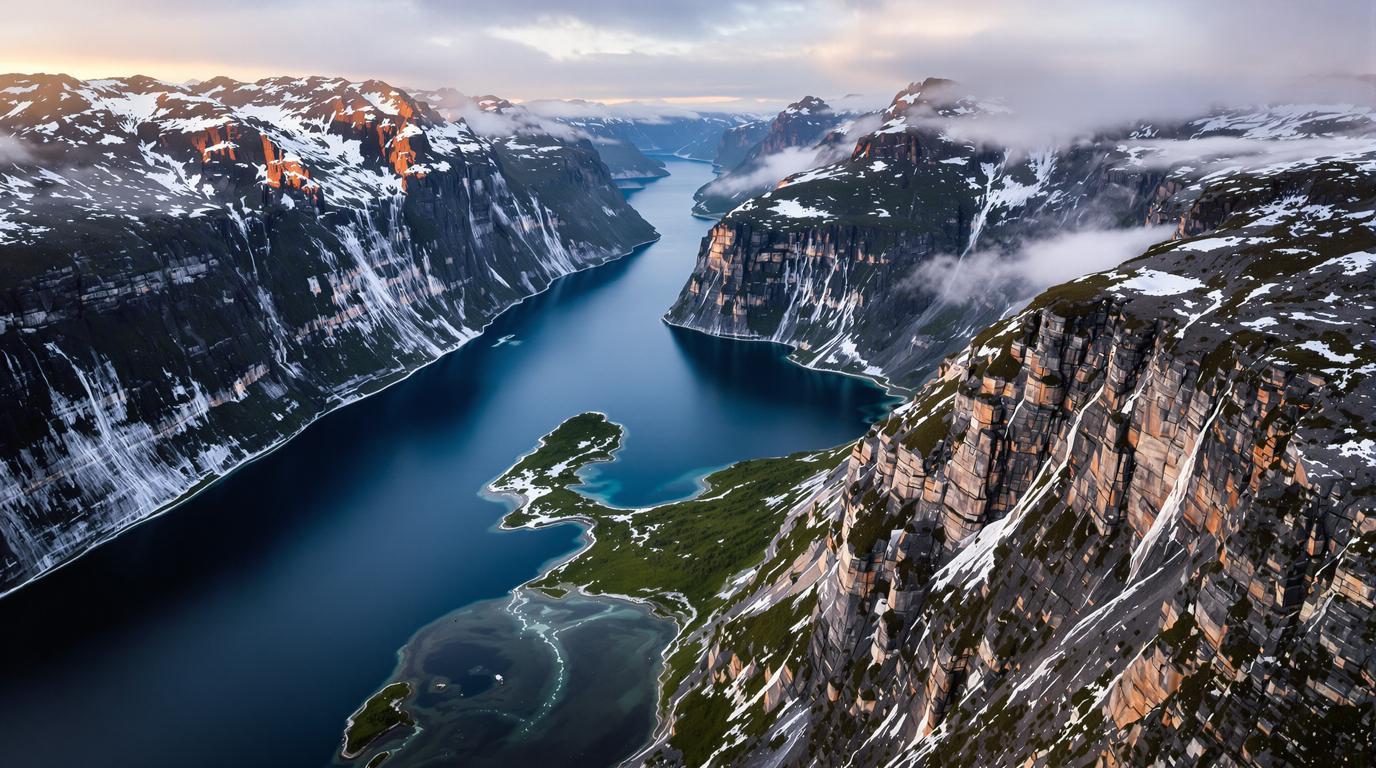The boat captain cut the engine as we entered Sognefjord’s deepest basin, where silence reveals geological secrets spanning two billion years. I’d spent weeks researching Norway’s fjords, but nothing prepared me for the moment our depth sounder hit 1,308 meters—deeper than Scotland’s Ben Nevis is tall. This isn’t just another Norwegian fjord; it’s the world’s deepest inland waterway, carved by glaciers thicker than skyscrapers into bedrock older than complex life itself.
Most travelers rush through on cruise ships, missing the profound geological story beneath their feet. But when you understand that Sognefjord plunges 1,308 meters below sea level while stretching 205 kilometers inland, you realize you’re witnessing Earth’s most dramatic testament to glacial power. The Scottish Highlands share this same ancient Caledonian foundation, yet Norway’s landscape tells a different story—one written in ice and time.
Local geologists I’ve spoken with describe Sognefjord as a living laboratory where 40 ice ages carved their signature into 500-million-year-old gneiss. During the last glaciation, ice sheets 3,000 meters thick ground through these mountains at one millimeter per year, creating the deepest fjord on Earth. Similar glacial forces shaped Alaska’s coastal geography, but nowhere else achieved Sognefjord’s incredible depth.
The Caledonian secret that connects Norway to Scotland’s ancient mountains
Why Sognefjord runs deeper than Highland peaks stand tall
The Caledonian orogeny, occurring 490 to 390 million years ago, created the mountain backbone that would later guide glacial carving. When Laurentia and Baltica collided, they formed the same mountain system that built Scotland’s Highlands and Norway’s spine. But here’s what makes Sognefjord extraordinary: while Scotland’s mountains represent the orogeny’s direct result, Norway’s fjords reveal what happened next—massive glaciers exploiting tectonic weaknesses to carve valleys deeper than most mountains are high.
The geological timeline that created Earth’s deepest waterway
Bergen University researchers confirmed that Sognefjord’s gneiss bedrock contains minerals dating back 2 billion years, making it older than the oxygen in our atmosphere. The Caledonian collision created fractures and valleys that glaciers later exploited, grinding through solid rock to create today’s 1,308-meter-deep basin. This geological formation process rivals other dramatic landscapes, but Sognefjord’s depth remains unmatched globally.
Hidden authenticity beyond the cruise ship crowds
The tributary fjords tourists never discover
While 700,000 annual visitors flock to Geirangerfjord, Sognefjord’s remote branches like Fjærlandsfjord and Lusterfjord remain virtually unknown. These narrow tributaries offer the same dramatic depths—Nærøyfjord plunges 500 meters—without the crowds. Local boat operators in Balestrand told me these hidden arms provide the most authentic fjord experience, where you can hear glacier-fed waterfalls echoing off ancient rock walls.
The glacier connection most travelers miss
Jostedalsbreen, mainland Europe’s largest glacier, feeds directly into Sognefjord through multiple arms. This active connection means you’re witnessing ongoing geological processes—the same ice-and-rock interaction that carved the fjord continues today. Water temperatures remain around 7.4°C year-round in the deep basin, a constant reminder of the glacial origins that created this underwater canyon.
The exclusive summer experience locals protect
Why July reveals Sognefjord’s greatest secrets
Summer 2025 offers optimal conditions for exploring Sognefjord’s depths without the harsh weather that limits winter access. Like other dramatic coastal destinations, timing determines your experience quality. Local guides recommend early morning departures from Flåm or Balestrand when mist reveals the fjord’s true scale—vertical walls disappearing into depths that would swallow the Empire State Building.
Travel Note: “The fjord’s depth creates its own weather system. We’ve measured temperature differences of 15 degrees between the surface and 100 meters down, creating microclimates that support unique ecosystems found nowhere else.” – Dr. Lars Eriksen, Marine Geologist, University of Bergen
The viewing points cruise passengers never see
Aurlandsfjord’s eastern shore offers the most dramatic perspective of Sognefjord’s true depth. Here, hiking trails lead to viewpoints where you can see the fjord’s U-shaped profile—evidence of glacial carving that distinguishes fjords from river valleys. These vantage points reveal why Sognefjord’s 1,308-meter depth represents such an extraordinary geological achievement.
Frequently Asked Questions
How does Sognefjord’s depth compare to other world records?
At 1,308 meters deep, Sognefjord exceeds Scotland’s Ben Nevis height by 970 meters. It’s deeper than the Grand Canyon and contains more water below sea level than any other fjord on Earth. The deepest parts remain unexplored due to extreme conditions and near-freezing temperatures.
What makes Sognefjord geologically unique from other Norwegian fjords?
Sognefjord’s exceptional depth results from its position along major Caledonian fault lines, allowing glaciers to carve deeper than elsewhere. Its 205-kilometer length also provided more time for glacial erosion, creating the world’s most dramatic underwater landscape carved into 2-billion-year-old bedrock.
When should I visit for the most authentic experience?
July through August offers the best weather and accessibility to remote tributaries. Early morning boat tours from Balestrand or Flåm provide the most intimate experience, avoiding cruise ship crowds while maximizing visibility of the fjord’s incredible depth and geological features.
Standing at Sognefjord’s edge, you’re witnessing two billion years of Earth’s history written in stone and carved by ice into the deepest story our planet tells. This ancient Caledonian foundation, shared with Scotland’s Highlands, became Norway’s canvas for glacial artistry unmatched anywhere on Earth. In a world of crowded destinations, Sognefjord offers something increasingly rare—authentic geological wonder that humbles human perspective while revealing nature’s patient, relentless creativity.
